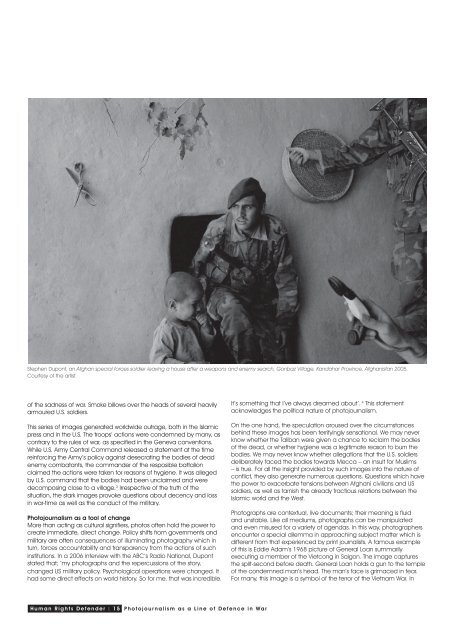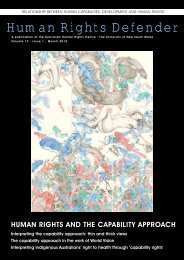'Photojournalism as a line of defence in war' by Brigit Morris
'Photojournalism as a line of defence in war' by Brigit Morris
'Photojournalism as a line of defence in war' by Brigit Morris
You also want an ePaper? Increase the reach of your titles
YUMPU automatically turns print PDFs into web optimized ePapers that Google loves.
Stephen Dupont, an Afghan special forces soldier leav<strong>in</strong>g a house after a weapons and enemy search, Gonbaz Village, Kandahar Prov<strong>in</strong>ce, Afghanistan 2005.Courtesy <strong>of</strong> the artist.<strong>of</strong> the sadness <strong>of</strong> war. Smoke billows over the heads <strong>of</strong> several heavilyarmoured U.S. soldiers.This series <strong>of</strong> images generated worldwide outrage, both <strong>in</strong> the Islamicpress and <strong>in</strong> the U.S. The troops’ actions were condemned <strong>by</strong> many, <strong>as</strong>contrary to the rules <strong>of</strong> war, <strong>as</strong> specified <strong>in</strong> the Geneva conventions.While U.S. Army Central Command rele<strong>as</strong>ed a statement at the timere<strong>in</strong>forc<strong>in</strong>g the Army’s policy aga<strong>in</strong>st desecrat<strong>in</strong>g the bodies <strong>of</strong> deadenemy combatants, the commander <strong>of</strong> the resposible battalionclaimed the actions were taken for re<strong>as</strong>ons <strong>of</strong> hygiene. It w<strong>as</strong> alleged<strong>by</strong> U.S. command that the bodies had been unclaimed and weredecompos<strong>in</strong>g close to a village. 3 Irrespective <strong>of</strong> the truth <strong>of</strong> thesituation, the stark images provoke questions about decency and loss<strong>in</strong> war-time <strong>as</strong> well <strong>as</strong> the conduct <strong>of</strong> the military.Photojournalism <strong>as</strong> a tool <strong>of</strong> changeMore than act<strong>in</strong>g <strong>as</strong> cultural signifiers, photos <strong>of</strong>ten hold the power tocreate immediate, direct change. Policy shifts from governments andmilitary are <strong>of</strong>ten consequences <strong>of</strong> illum<strong>in</strong>at<strong>in</strong>g photography which <strong>in</strong>turn, forces accountability and transparency from the actions <strong>of</strong> such<strong>in</strong>stitutions. In a 2006 <strong>in</strong>terview with the ABC’s Radio National, Dupontstated that; ‘my photographs and the repercussions <strong>of</strong> the story,changed US military policy. Psychological operations were changed. Ithad some direct effects on world history. So for me, that w<strong>as</strong> <strong>in</strong>credible.It’s someth<strong>in</strong>g that I’ve always dreamed about’. 4 This statementacknowledges the political nature <strong>of</strong> photojournalism.On the one hand, the speculation aroused over the circumstancesbeh<strong>in</strong>d these images h<strong>as</strong> been terrify<strong>in</strong>gly sensational. We may neverknow whether the Taliban were given a chance to reclaim the bodies<strong>of</strong> the dead, or whether hygiene w<strong>as</strong> a legitimate re<strong>as</strong>on to burn thebodies. We may never know whether allegations that the U.S. soldiersdeliberately faced the bodies towards Mecca – an <strong>in</strong>sult for Muslims– is true. For all the <strong>in</strong>sight provided <strong>by</strong> such images <strong>in</strong>to the nature <strong>of</strong>conflict, they also generate numerous questions. Questions which havethe power to exacerbate tensions between Afghani civilians and USsoldiers, <strong>as</strong> well <strong>as</strong> tarnish the already fractious relations between theIslamic world and the West.Photographs are contextual, live documents; their mean<strong>in</strong>g is fluidand unstable. Like all mediums, photographs can be manipulatedand even misused for a variety <strong>of</strong> agend<strong>as</strong>. In this way, photographersencounter a special dilemma <strong>in</strong> approach<strong>in</strong>g subject matter which isdifferent from that experienced <strong>by</strong> pr<strong>in</strong>t journalists. A famous example<strong>of</strong> this is Eddie Adam’s 1968 picture <strong>of</strong> General Loan summarilyexecut<strong>in</strong>g a member <strong>of</strong> the Vietcong <strong>in</strong> Saigon. The image capturesthe split-second before death. General Loan holds a gun to the temple<strong>of</strong> the condemned man’s head. The man’s face is grimaced <strong>in</strong> fear.For many, this image is a symbol <strong>of</strong> the terror <strong>of</strong> the Vietnam War. InHuman Rights Defender : 15 Photojournalism <strong>as</strong> a L<strong>in</strong>e <strong>of</strong> Defence <strong>in</strong> War



